| Notes: The Midland Railways London Extension into St. Pancras was ready for inspection in July 1868 but the Board of Trade inspector refused to sanction the opening of St. Pancras itself because the approaches to the station were, at that time unfinished. The inspector was however happy with the rest of the line and agreed to the opening of the line between Bedford and |
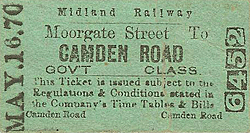 |
Camden Town where there was a junction that allowed trains to run into the Metropolitan Line's station at Moorgate Street. The line was opened between Bedford and Moorgate street on 13th July 1868 with intermediate stations with the London area at Hendon, Finchley Road & St Johns Wood, Haverstock Hill, Kentish Town and Camden Road. Work on the approaches to St. Pancras continued and the station finally opened on 1st October 1868.
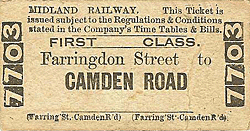 |
The station was sited in a cutting with tall brick retaining walls immediately north of the Camden Road Tunnels, and its street level building stood on the north western side of Camden Road, alongside the junction with Sandall Road. The station had two side platforms on the east side of the formation with wooden framework and paneling at the back of the the down |
platform separating the platform from the goods lines.
| The brick built street level building was irregularly shaped with its west side wider than its east. It was set back from the road with a small forecourt, which was separated from the main thoroughfare by a low brick wall, topped with iron railings. There was an exit door on the west side in Sandall Road. The building incorporated the booking office general and first class |
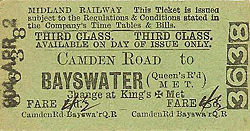 |
class waiting rooms and a ladies’ room. Separate double doors let to stairs down to the platforms. At the south end of the station the whole formation was covered by an overall roof supported on iron girders which spanned the cutting. Beyond this was an occupation bridge and on it's far side the platforms had conventional awnings supported by girders protecting most of the platform length.
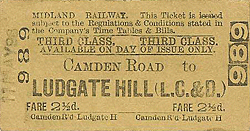 |
The overall section of roof retained smoke from passing trains and two years after opening the roof was removed. A signal box was provided by 1877, this was replaced by a new box on 5th June 1887 and this in turn was replaced by a temporary cabin on 11th September 1897 when the formation was widened on the up side for two new slow lines and also requiring |
the the construction of a new tunnel alongside the existing one. The original passenger tracks became the fast lines, but the goods lines remained unchanged. As part of the scheme, a new up slow line platform was provided at Camden Road whilst the existing up platform was rebuilt as an island. The old down platform of 1868 was retained and now served the down fast. At this time the platforms were provided with new buildings and a footbridge at the rear of the street level building; the girders that supported the awnings were removed and replaced by new canopies supported on iron columns.
| Initially Camden Road was popular with 269,048 tickets issued in 1872 but these numbers gradually declined with a marked drop in passenger numbers in the early years of the 20th century with the introduction of more convenient road transport. In 1915 only 10,728 tickets were issued and as part of a general economy measure during WW1 the station closed on |
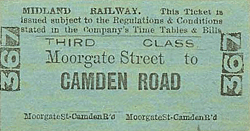 |
1st January 1916 and never reopened.
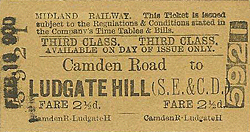 |
building was retained and converted into a petrol station; it was substantially rebuilt in the 1960s and from the front was barely recognisable. The stairway to the down platform also remain in place until the late 1960s. The building was eventually demolished and replaced by a new petrol station leaving only the back wall of the original building as part of the bridge |
parapet; its bricked up windows remaining clearly visible. The garage was closed and demolished in 2009 with a new motor vehicle maintenance and repair workshop under construction in 2010.
Sources:London's Disused Stations Volume 7 The Midland Railway by J E Connor. Published 2009 by Connor & Butler. ISBN 978 0 947699 42 2
For more pictures of Haverstock Hill station see Abandoned Tube Stations web site
Ticket from Michael Stewart, timetable from Glynn Waite, route map drawn by Alan Young
For other Midland Railway London suburban stations click on the station name: Hendon Factory Platform, Welsh Harp, Finchley Road, Haverstock Hill,
Dudding Hill & Harlesden for West Willesden & Stonebridge Park |

road_old3.jpg)
road_old1.jpg)
road11.jpg)
road4.jpg)
road8.jpg)
road10.jpg)
road14.jpg)










road_old_thumb2.jpg)
road_thumb1.jpg)
road_thumb2.jpg)
road_thumb3.jpg)
road_thumb5.jpg)
road_thumb6.jpg)
road_thumb7.jpg)
road_thumb9.jpg)



 Home Page
Home Page